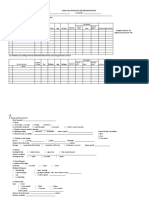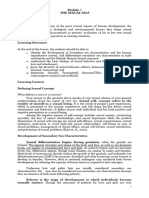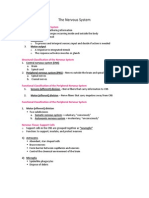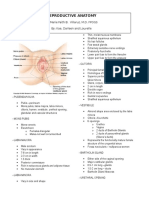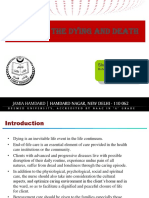Reproductive Health Reproductive Development - Intrauterine Development
Reproductive Health Reproductive Development - Intrauterine Development
Uploaded by
MabesCopyright:
Available Formats
Reproductive Health Reproductive Development - Intrauterine Development
Reproductive Health Reproductive Development - Intrauterine Development
Uploaded by
MabesOriginal Description:
Original Title
Copyright
Available Formats
Share this document
Did you find this document useful?
Is this content inappropriate?
Copyright:
Available Formats
Reproductive Health Reproductive Development - Intrauterine Development
Reproductive Health Reproductive Development - Intrauterine Development
Uploaded by
MabesCopyright:
Available Formats
Reproductive Health - includes all aspects of sexuality thru life span.
Reproductive Development Begins at the moment of conception and continues throughout life. Intrauterine Development The sex of an individual is determined at the moment of conception by the chromosome information supplied by the particular ovum and sperm that joined to create new life. Gonad body organ that produces sex cells or gametes a. In Females 1. Ovaries (2) female gonads 2. Ova or Egg female sex cells produced by ovaries b. In Males 1. Testes (2)- male gonads 2. Sperm male sex cells produced by testes Pubertal Development Puberty stage of life which secondary sex changes begin.
Hypothalamus Synthesize Releases Gondadotropin Releasing factor (GnRf) Triggers Anterior Pituitary Gland Release Gondadrotropic Hormones Follicle Stimulating Hormone (FSH) and Luteinizing Hormone (LH) Initiates the Production of Andorgen and Estrogen, which in turn initiate Secondary Sex Characteristics.
Hypothalamus serves as gonadostat or regulation mechanism to turn on gonad functioning during puberty Role of Androgen or Androgenic Hormones Hormones responsible for muscular development, physical growth, and increase in sebaceous glands that causes acne in both boys and girls. In males, it is produced by Adrenal Cortex and Testes. In females, it is produced by Adrenal Cortex and Ovaries Levels of Androgenic hormone, TESTOSTERONE are low in Males until Puberty (Approximately 12 14 yrs old). At the time of puberty, testosterone rises to influence: a. Development of Testes, Scrotum, Penis, Prostate Gland, Seminal Vesicles b. Appearance of Pubic, Facial, and Axillary Hair c. Laryngeal Enlargement accompanied by Voice Change d. Maturation of Spermatozoa e. Closure of Long Bone Growth
Role of Estrogen When triggered during Puberty, Ovarian Follicles begin to excrete a high level of estrogen. Composed of 3 compounds a. Estrone (E1) b. Estradiole (E2) c. Estriol (E3) Increase of estrogen in females during puberty influences a. Development of fallopian tubes, uterus, and vagina b. Fat distribution and hair patterns c. Breast Development (Thelarche beginning of Breast Development) d. Closure of Epiphyses of Long Bones Secondary Sex Characteristics or Pubertal Changes in Females 1. 2. 3. 4. 5. Growth Spurt Increase in transverse diameter of pelvis Breast development Growth of Pubic Hair Onset of Menstruation (Menarche 1st menstrual period; occurs at 12.4 yrs. May occur as early as 9 and as late as 17) 6. Growth of Axillary Hair 7. Vaginal Secretions Secondary Sex Characteristics or Pubertal Changes in Males 1. 2. 3. 4. 5. 6. 7. Increase in Weight Growth of testes Growth of facial, axillary, and pubic hair Voice change Penile growth Increase in height Spermatogenesis (Production of Sperm)
Sexuality A multidimensional phenomenon that includes feelings, attitudes, and actions. Has both biologic and cultural components Encompasses and gives directions to a persons physical, emotional, social, and intellectual responses throughout life. Biologic gender denote a persons chromosomal sex: male (xy) and female (xx) Gender Role A male or female behaviour a person exhibits, w/c may be the same or different from Gender Identity. Culturally influenced (ex. In the past, women has nurturing qualities with the responsibility for childrearing and childbearing; men are viewed as financial providers) More interchangeable (ex. Women pursue all types of jobs without loss of feminity and men participate in childrearing and household chores w/o loss of masculinity)
Gender Identity or Sexual Identity Inner sense of a person has of being a male or female, w/c may be the same or different from Gender Role Develop throughout an entire lifespan May be influenced by the ff: a. Amount of testosterone secreted in utero (Sex Typing) may affect how gender develops. b. Role modelling of parents may also influence how a child envisions himself or herself. Development of Gender Identity 1. Infancy (First 12 months of life) from the day birth, female and male babies are treated differently by their parents People generally bring girls dainty dresses, treated gently and held and rocked more tha male babies. 2. Pre-school Period (3 4 yrs old) Children can distinguish between male and females as early as 2y/o By ages 3 or 4, they can say what sex they are and have absorbed cultural expectations of that sex role. a. Development of Oedipus complex (Strong emotional attachment of preschool boy for his mother and preschool girl to her father) may be overstated by Freud as a sexual bias. Oedipus Complex son to mother b. Electra Complex daughter to father 3. School Age Child (6 12 yrs old) Imitators; Imitation of Adult Roles as a way of learning gender roles Ex. Child imitates his father who is a doctor 4. Adolescent (12 18 yrs old) Begins the process of establishing sense of identity, the problem of final gender role identification rises again. Needs guidelines for safer sex to reduce risk of STIs. Stressful time for a boy who realizes that he is gay or the girl that she is lesbian. High Suicidal rate due to homosexual teenagers feels so lost. 5. Young Adult Young adults move away from home to attend college or establish their own home Change in eating pattern can increase or decrease their changes in body image Choose the way they will express their sexuality along with other life patterns Marry with a commitment to one sexual partner Establish Cohabitation (learning more about a possible marriage partner on a day to day basis in the hope that future marriage will be stronger and lasting) Conflicts in parenting occur if an individual gender doesnt meet the expectation of a family. Young couples begins childbearing 6. Middle Age Adult Sexuality has achieved a degree of stability A sense of masculinity and femininity have been established Adults allow themselves more freedom in exploring and satisfying sexual needs. Re-examination of life goals, careers, accomplishments, values, familial and social systems
7. Older Adult Both male and female continue to enjoy active sexual relationships. Some men experience less erectile firmness Some women have less vaginal secretions d/t less estrogen after menopause. 4 Stages of Human Sexual Response Cycle 1. Excitement Occurs with physical and psychological stimulation that causes parasympathetic nerve stimulation. (Ex. Sound, sight, emotion, thoughts) that leads to arterial dilatation and venous constriction in genital area. Increased blood supply leads to VASOCONGESTION a. In women Increase of the size of clitoris and mucoid fluid as lubrication Vagina widens in diameter and increases in length Nipples become erect b. In males Penile Erection Scrotal Thickening Elevation of Testes c. In Both sexes Increase in PR, HR, and BP 2. Plateau Stage Reached just before orgasm In woman, clitoris drawn forward and retracts under clitoral prepuce, lower part of vagina becomes congested (formation of orgasmic platform), & inceasednipple elevation In men, vasocongestion leads to full distention of the penis Heart Rate increases to 100 175 bpm Respiratory Rate increases to 40 bpm 3. Orgasm Body suddenly discharges accumulated sexual tension. Vigorous contraction of muscles in pelvic area expels blood and fluid from the area of congestion. Ave. No of contractions for woman is 8 15 contractions at intervals of 1 every 0.8 seconds In men, muscle contractions surrounding the seminal vesicles and prostate semen into proximal urethra. These contractions are followed immediately by 3 7 propulsive ejaculatory contractions, occurring at the same time interval as women which force semen out from the penis. The shortest stage in Sexual response Cycle; Highly Personal Experience 4. Resolution 30 minute period during which the internal and external genitals returns to an unaroused state. In males, refractory period occurs which further orgasms is impossible. Women dont go into refractory period, so its possible for women who are interested and properly stimulated to have additional orgasms immediately. Controversies about female Orgasm: The existence of the G Spot
Types of Sexual Orientation 1. Heterosexual finds sexual fulfilment with the opposite sex or gender. 2. Homosexuality finds sexual fulfilment with the same gender ; Gay and lesbians 3. Bisexuality sexual satisfaction from both homosexual and heterosexual relationships; have greater risk for HIV and STIs. 4. Transexuality or Transgender an individual who although of one biologic gender, feels as if he or she is of the opposite gender; some have sex change operations Types of Sexual Expression 1. Sexual Abstinence or Celibacy separation from sexual activity; avowed state of certain religious orders; advantage is the ability to concentrate on means of giving and receiving love other than sexual expression; most effective way to prevent pregnancy and STIs. 2. Masturbation Self stimulation for erotic pleasure; offers sexual release which may be interpreted by the person as overall tension or anxiety relief. Children between 2 6 yrs old find it enjoyable to explore their bodies. School Aged Children continue to use it for enjoyment but perform in private. Autoerotic Asphyxia practice of causing oxygen deficiency (usually by hanging) during masturbation with the goal of producing a feeling of extreme sexual excitement; act can be fatal 3. Erotic Stimulation use of visual aids such as magazines or photographs for sexual arousal 4. Fetishism sexual arousal by the use of objects or situations 5. Transvestism individual who dresses in the clothes of opposite sex; can be heterosexual, homosexual, or bisexual 6. Voyeurism sexual arousal by looking at anothers body 7. Sadomasochism involves inflicting pain (Sadism) or receiving pain (masochism) to achieve sexual satisfaction 8. Exhibitionism revealing genitals in public 9. Bestiality sexual relationships with animals 10. Pedophiles interested in sexual encounters with children; registered sex offenders Disorders of Sexual Functioning 1. Inhibited Sexual Desire lessened interest in sexual relations Normal in some situations such as death of family member divorce, stressful job, etc. Side effect on some medicines ; Obese people finds it difficult in deep penetration 2. Failure to Achieve Orgasm result of poor sexual technique, concentrating too hard or negative attitudes toward sexual relationships. 3. Erectile Dysfunction or Impotence inability of a man to produce or maintain erection long enough for vaginal penetration 4. Premature Ejaculation ejaculation before penile vaginal contact Frustrating for both partners Cause can be Psychological; Fear of Impregnating a partner 5. Persistent Sexual Arousal Syndrome (PSAS) Excessive and unrelenting sexual arousal in the absence of desire. Ask if taking Herbal Remedies such as Gingko Biloba, can have arousal effects.
Pain Disorders 1. Vaginismus involuntary contraction of the muscles at the outlet of the vagina when coitus is attempted that prohibits penile penetration. 2. Dyspareunia pain during coitus May occur due to: a. Endometriosis (abnormal placement of endometrial tissue) b. Vestibulitis (inflammation of the vestibule) c. Vaginal Infection d. Hormonal Changes (menaupause and causes vaginal drying)
You might also like
- The Ukfpo Clinical Assessment Examination Guide by Sarishka Singh Plab ResourcesDocument112 pagesThe Ukfpo Clinical Assessment Examination Guide by Sarishka Singh Plab ResourcesWonjoo LeeNo ratings yet
- Module 4 RLE Activity NeriDocument9 pagesModule 4 RLE Activity NeriAngela Neri75% (4)
- Evolution 1st Edition Bergstrom Test BankDocument13 pagesEvolution 1st Edition Bergstrom Test Bankhungden8pne100% (43)
- ABRO Spray Paint PDFDocument6 pagesABRO Spray Paint PDFJesus Asnate50% (4)
- The Science of Drinking - How Alcohol Affects Your Body and Mind PDFDocument277 pagesThe Science of Drinking - How Alcohol Affects Your Body and Mind PDFSanjeev Choudhary100% (1)
- Sugar Fermentation TestDocument15 pagesSugar Fermentation TestUmesh Chikhlikar67% (3)
- Chapter 52 - Drugs Affecting The Urinary Tract and The BladderDocument12 pagesChapter 52 - Drugs Affecting The Urinary Tract and The BladderJonathonNo ratings yet
- Prof Ad BON and NursesDocument7 pagesProf Ad BON and NursesMabesNo ratings yet
- Nutrition and Diet Therapy Summary of BookDocument17 pagesNutrition and Diet Therapy Summary of BookMabes100% (6)
- Notes - MCHN - Chapter 1Document12 pagesNotes - MCHN - Chapter 1Jamaica mitalNo ratings yet
- Diets Modified in CompositionDocument9 pagesDiets Modified in Compositioncriselda desistoNo ratings yet
- OBE Syllabus LogicDocument8 pagesOBE Syllabus LogicMaria Lourdes S. Alcoriza100% (1)
- 107 Answer KeyDocument8 pages107 Answer KeyKryzza LeizellNo ratings yet
- I. Mother and Child HealthDocument70 pagesI. Mother and Child Healthconahs nasugbuNo ratings yet
- Drugs Affecting The Renal SystemDocument8 pagesDrugs Affecting The Renal SystemAmandaNo ratings yet
- Student Copy Conti - Intrapartal Week8Document25 pagesStudent Copy Conti - Intrapartal Week8Toyour EternityNo ratings yet
- Ethical Issues IVFDocument1 pageEthical Issues IVFBasinga OkinamNo ratings yet
- Introduction To Bioethics 1Document31 pagesIntroduction To Bioethics 1ivernjayNo ratings yet
- Health Education Prelim)Document3 pagesHealth Education Prelim)Joselyn Cabiles-GanhinhinNo ratings yet
- Ncm107mch Module1 FrameworkDocument30 pagesNcm107mch Module1 FrameworkVenus Anne LamayoNo ratings yet
- HEALTH-Environmental SanitationDocument30 pagesHEALTH-Environmental SanitationMae Sotto DavidNo ratings yet
- BioethicsDocument11 pagesBioethicsgabbybibobuNo ratings yet
- NCM107Document11 pagesNCM107Mutya XDNo ratings yet
- MCN Quiz and AnswersDocument9 pagesMCN Quiz and AnswersHiraya Teodoro GrimaldoNo ratings yet
- Community Health NursingDocument5 pagesCommunity Health NursingMarjun DelavinNo ratings yet
- MCHN Must READDocument56 pagesMCHN Must READjay5ar5jamorabon5torNo ratings yet
- Maternal Lectures EditedDocument77 pagesMaternal Lectures EditedSHEENA MAE DE LOS REYESNo ratings yet
- Ncam219 Lec PDFDocument102 pagesNcam219 Lec PDFDAVE BARIBENo ratings yet
- Concept of Unitive and ProcreativeDocument27 pagesConcept of Unitive and ProcreativeKobs Foreigner100% (1)
- 5 Diversity and Maternal Child NursingDocument50 pages5 Diversity and Maternal Child NursingBryan Lloyd Ballestar RayatNo ratings yet
- INTRAPARTAL CARE - MaternalDocument8 pagesINTRAPARTAL CARE - MaternalMae CalicaNo ratings yet
- GordonDocument4 pagesGordonShekinah Fuellas CantorNo ratings yet
- MCHN 3RD LectDocument9 pagesMCHN 3RD LectZahNo ratings yet
- Prenatal CareDocument2 pagesPrenatal CareMelvin AurelioNo ratings yet
- 1 Labor and Delivery ProcessDocument13 pages1 Labor and Delivery ProcessBardiaga JmayNo ratings yet
- VitaminsDocument3 pagesVitaminsJamil Samira E. BuizonNo ratings yet
- Spiritual TheoryDocument2 pagesSpiritual TheorychfalgueraNo ratings yet
- Care of The Mother and The Fetus During The Prenatal Period (Part 2)Document20 pagesCare of The Mother and The Fetus During The Prenatal Period (Part 2)Austine James Sabenicio PantiloNo ratings yet
- Fitness MatricesDocument4 pagesFitness Matricesapi-256577647No ratings yet
- The Family - Community Heath NursingDocument8 pagesThe Family - Community Heath NursingJASMIN ROSE SALSESNo ratings yet
- FNCP FormatDocument12 pagesFNCP FormatChristi MilanNo ratings yet
- 3 - Human Sexuality and ReproductionDocument15 pages3 - Human Sexuality and ReproductionLucas JelmarNo ratings yet
- Planning For Health Promotion, Health Maintenance and Home Health Considerations Risk Reduction, and Disease PreventionDocument5 pagesPlanning For Health Promotion, Health Maintenance and Home Health Considerations Risk Reduction, and Disease PreventionMarianne DugosNo ratings yet
- Midwifery Skills Clinical Laboratory: The Midwives ProcessDocument26 pagesMidwifery Skills Clinical Laboratory: The Midwives ProcessNano KaNo ratings yet
- Context-Environment To Which Nursing Act Takes Place Content - Subject of Theory Process - Method by Which Nurse Acts in Nursing Theory NursingDocument22 pagesContext-Environment To Which Nursing Act Takes Place Content - Subject of Theory Process - Method by Which Nurse Acts in Nursing Theory NursingShyenNo ratings yet
- Aparicio Ryan Shane Y. Toddler AssessmentDocument24 pagesAparicio Ryan Shane Y. Toddler AssessmentThea DuoNo ratings yet
- Involving Family, Domestic Relations, Women and Children. (2015) - Philippine JudicialDocument10 pagesInvolving Family, Domestic Relations, Women and Children. (2015) - Philippine JudicialAngel MayNo ratings yet
- Notes On Nursing: What It Is and What It Is Not Was A Book First Published by FlorenceDocument7 pagesNotes On Nursing: What It Is and What It Is Not Was A Book First Published by FlorenceAlexis Nichole PayaoNo ratings yet
- University of Saint Louis Tuguegarao City, Philippines: Maternal and Child Health NursingDocument70 pagesUniversity of Saint Louis Tuguegarao City, Philippines: Maternal and Child Health NursingSam PothNo ratings yet
- WEEK 1 CU1 History of Health EducationDocument5 pagesWEEK 1 CU1 History of Health EducationDaichi100% (1)
- CHN 1 Family Nursing ProcessDocument63 pagesCHN 1 Family Nursing ProcessMark FernandezNo ratings yet
- Department of Health: "Quality Is Above Quantity" - Philosophy of DOHDocument2 pagesDepartment of Health: "Quality Is Above Quantity" - Philosophy of DOHPatricia RamosNo ratings yet
- Module 2 Entrep in NSGDocument15 pagesModule 2 Entrep in NSGMarie Ashley CasiaNo ratings yet
- Chapter 33 HygieneDocument14 pagesChapter 33 HygieneKathleen FrugalidadNo ratings yet
- Prenatal Management (Part 4)Document17 pagesPrenatal Management (Part 4)Austine James Sabenicio PantiloNo ratings yet
- Health Care Ethics Activity 2Document6 pagesHealth Care Ethics Activity 2Kyla BeconiaNo ratings yet
- 6-Health Problems Common in PreschoolerDocument36 pages6-Health Problems Common in PreschoolerPam Lala100% (2)
- MODULE 3 Infection and Host Resistance PDFDocument22 pagesMODULE 3 Infection and Host Resistance PDFVillanueva, AbegailNo ratings yet
- Healthteachingfortuberculosish EtobeprintedDocument2 pagesHealthteachingfortuberculosish EtobeprintedCake ManNo ratings yet
- Performance Checklist in The Delivery Room: On AdmissionDocument5 pagesPerformance Checklist in The Delivery Room: On AdmissionSHAYNE MERYLL CHANNo ratings yet
- Prenatal Substance Dependence AbuseDocument13 pagesPrenatal Substance Dependence Abusenursereview100% (2)
- Mercer's Maternal Role Attainment TheoryDocument7 pagesMercer's Maternal Role Attainment TheoryFrances Joei O. PEREZNo ratings yet
- Family Survey ToolmiriamDocument9 pagesFamily Survey ToolmiriamMushy_ayaNo ratings yet
- What Is A Health Care Profession?: Chapter Iv: The Calling of The Health Care ProviderDocument14 pagesWhat Is A Health Care Profession?: Chapter Iv: The Calling of The Health Care ProviderNur SanaaniNo ratings yet
- Chapter 7. The Sexual SelfDocument14 pagesChapter 7. The Sexual SelfdocgioreNo ratings yet
- Module4 UTSDocument11 pagesModule4 UTSjeruscalulangNo ratings yet
- CHN GapuzDocument23 pagesCHN GapuzMabes100% (1)
- Asepsis and InfectionDocument6 pagesAsepsis and InfectionMabes100% (1)
- PainDocument3 pagesPainMabesNo ratings yet
- Bowel Diversion: Parameter Colostomy IleostomyDocument1 pageBowel Diversion: Parameter Colostomy IleostomyMabesNo ratings yet
- Commonly Asked Emergency DrugsDocument17 pagesCommonly Asked Emergency DrugsrianneNo ratings yet
- PositioningDocument3 pagesPositioningMabesNo ratings yet
- Triage PrinciplesDocument2 pagesTriage PrinciplesMabesNo ratings yet
- Decubitus Ulcer / Pressure SoresDocument1 pageDecubitus Ulcer / Pressure SoresMabesNo ratings yet
- Therapeutic Diet NutritionistDocument3 pagesTherapeutic Diet NutritionistMabesNo ratings yet
- Enema Administration: Size of Rectal TubeDocument3 pagesEnema Administration: Size of Rectal TubeMabesNo ratings yet
- Parenteral Therapy:: Intravenous Therapy (IVT) or VenipunctureDocument3 pagesParenteral Therapy:: Intravenous Therapy (IVT) or VenipunctureMabes100% (1)
- Mabes Fluid and Electrolyte ImbalancesDocument15 pagesMabes Fluid and Electrolyte ImbalancesMabesNo ratings yet
- Blood Transfusion Purpose: 9. Check Blood For Presence of BubblesDocument2 pagesBlood Transfusion Purpose: 9. Check Blood For Presence of BubblesMabes100% (1)
- All Nursing TheoriesDocument26 pagesAll Nursing TheoriesMabesNo ratings yet
- Basic or InstrumentsDocument21 pagesBasic or InstrumentsMabes100% (1)
- Roses Are Red, Violets Are Blue, Without Your Lungs Your Blood Would Be, Too.Document249 pagesRoses Are Red, Violets Are Blue, Without Your Lungs Your Blood Would Be, Too.MabesNo ratings yet
- Nervous SystemDocument11 pagesNervous SystemMabesNo ratings yet
- Taste and SmellDocument1 pageTaste and SmellMabesNo ratings yet
- Fat Soluble VitaminsDocument5 pagesFat Soluble VitaminsMabesNo ratings yet
- Suture and NeedlesDocument5 pagesSuture and NeedlesMabesNo ratings yet
- Nutritional Recommendation For Cardiovascular DiseaseDocument5 pagesNutritional Recommendation For Cardiovascular DiseaseMabesNo ratings yet
- Water Soluble VitaminsDocument6 pagesWater Soluble VitaminsMabesNo ratings yet
- The Concepts of Man and His Basic NeedsDocument5 pagesThe Concepts of Man and His Basic NeedsMabes94% (18)
- Factors That Affect Eating and NurtritureDocument3 pagesFactors That Affect Eating and NurtritureMabesNo ratings yet
- Basic Therapeutic DietsDocument3 pagesBasic Therapeutic DietsMabes100% (1)
- Introduction To Nursing TheoriesDocument7 pagesIntroduction To Nursing TheoriesMabes100% (2)
- Treatment of Sexual DysfunctionDocument70 pagesTreatment of Sexual Dysfunction陳琮方100% (1)
- Jadwal Kegiatan Blok Xxiii-2020-2021Document5 pagesJadwal Kegiatan Blok Xxiii-2020-2021Kinanti Lingga PutiNo ratings yet
- General Dentistry-CaseDocument130 pagesGeneral Dentistry-CaseChokri SahbaniNo ratings yet
- Pediatric Klüver-Bucy Syndrome Report of TwoDocument8 pagesPediatric Klüver-Bucy Syndrome Report of TwofernandogfcnsNo ratings yet
- Reproductive AnatomyDocument10 pagesReproductive AnatomyjuhlynNo ratings yet
- B2Document13 pagesB2NadaemiliaNo ratings yet
- Sample+Simulation+Scenarios 08-2017 MedPro+GroupDocument62 pagesSample+Simulation+Scenarios 08-2017 MedPro+GroupGursimran RajvanshNo ratings yet
- Hemolytic Disease of The NewbornDocument16 pagesHemolytic Disease of The NewbornStanculescu MarianaNo ratings yet
- EpilepsyDocument38 pagesEpilepsyB Au100% (1)
- Manoj KR - KakatiDocument5 pagesManoj KR - Kakatimanoj kakatiNo ratings yet
- Risk Factors of DiabetesDocument29 pagesRisk Factors of DiabetesFarrukh Ali BaigNo ratings yet
- Biology Checkpoint Topics Part 1Document36 pagesBiology Checkpoint Topics Part 1esteban ferrada silvaNo ratings yet
- Internet Trends 2014 KPCBDocument164 pagesInternet Trends 2014 KPCBtaoNo ratings yet
- SN Chugh - Bedside Medicine Without TearsDocument454 pagesSN Chugh - Bedside Medicine Without Tearsnb280100% (11)
- Budgerigar Fledgling Disease (Papovavirus) in Pet BirdsDocument4 pagesBudgerigar Fledgling Disease (Papovavirus) in Pet BirdsFiroz RezaNo ratings yet
- Care of Dying PatientDocument21 pagesCare of Dying PatientDeepti KukretiNo ratings yet
- Example of A Thesis Statement For An EssayDocument7 pagesExample of A Thesis Statement For An Essayafibxprddfwfvp100% (2)
- AgoniaDocument24 pagesAgoniaTunjung Manhatanti AviantaraNo ratings yet
- Dyspepsia Guidelines 2012 From NHSDocument3 pagesDyspepsia Guidelines 2012 From NHSCitra Yuriana PutriNo ratings yet
- Diagnostic Test DesignDocument30 pagesDiagnostic Test DesignDika Gita PratamaNo ratings yet
- PS 5 Lec 1 IntroDocument9 pagesPS 5 Lec 1 IntronickalecdecesareNo ratings yet
- ΘΕΜΑΤΑ ΠΑΝΕΛΛΗΝΙΩΝ ΑΓΓΛΙΚΑ 2009Document3 pagesΘΕΜΑΤΑ ΠΑΝΕΛΛΗΝΙΩΝ ΑΓΓΛΙΚΑ 2009ΦΩΤΙΟΣ ΓΟΥΣΙΟΣNo ratings yet
- Pharmacotherapeutics - I: Case Study On Anterior Wall Myocardial InfarctionDocument20 pagesPharmacotherapeutics - I: Case Study On Anterior Wall Myocardial InfarctionDr. Suba Senthil0% (1)
- Third Eyelid Gland Neoplasms of Dogs and CatsDocument6 pagesThird Eyelid Gland Neoplasms of Dogs and CatsMicheleBerselliNo ratings yet
- Ophthalmic Drug Delivery Systems - Recent AdvancesDocument26 pagesOphthalmic Drug Delivery Systems - Recent AdvancescbcalderonNo ratings yet






























































